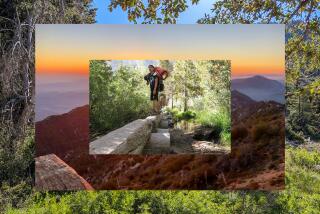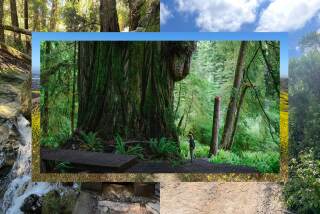Roadside Rests Can Be the Pits
It’s probably happened to you: You’re on a road trip, cruising down the interstate. You’re far enough away from here, but not quite there.
Then it hits you as suddenly as a blast of wiper fluid on your windshield. You NEED to stop.
The blue sign with the white letters appears on the horizon--”Rest Area, Next Exit”--and your mind may fill with competing thoughts: OK, finally, toilets and a drinking fountain. But will they be clean? I can stretch my legs. But will there be more than a patch of shade? Or, if it’s night, will there be enough lighting, or people, around so I don’t feel like I’m about to become a victim in my own horror flick?
Each year, about 100 million travelers looking for rest and relief stop at the 88 rest areas scattered throughout California, according to the state Department of Transportation.
What they find at those freeway pit stops is often spartan, outfitted with only the most basic necessities: toilets and sinks inside a bare, cinder-block structure. No paper towels, no vending machines. The truly deluxe rest stops offer picnic areas with scenic views, snacks and plenty of parking for recreational vehicles.
It can be hit or miss when it comes to the roadside retreats--so much so that one lawmaker has suggested that the way stations need a little sprucing up, care of the private sector.
But in rest stops, as in life, everything is relative. And the man who wrote the book on the topic says California’s freeway pit stops are actually among the best in the West.
Gerald Hammon has written three versions of the “Rest Area Guide,” each covering a separate portion of the West.
“There are some that are pretty basic, but if you’ve got to go, that’s all you need,” he said. “I think California rest areas are pretty good.”
Hammon, a retiree and freelance writer, spent a year visiting every rest area in the state with his wife. The facilities are ranked on a scale of one to four toilets, four signifying the finest facilities.
Hammon said he would rank California rest stops among the top four of 11 Western states for cleanliness, available parking, restroom crowding, and amenities such as telephones and vending machines.
Sometimes low expectations and a desperate bladder can make even the state’s most austere rest stops look like sparkling oases.
“They’re pretty clean compared to other places,” said Eric Donaty, a Los Angeles dentist and frequent road-tripper. “They’re well kept up.”
The state spends about $11.3 million a year on rest-area upkeep.
“Vandalism and litter are not big problems,” Caltrans spokesman Gene Berthelsen said. “Most people appear to stop and throw their trash into the receptacles.”
Hammon did note one litter problem that appeared in several restrooms.
“For God’s sake, use a roll of toilet paper, not the individual sheets,” he said. “They make a huge mess when someone pulls out handfuls at a time. They wind up all over the floor.”
California’s first rest area was created in 1962. It and the dozens of freeways stopovers that would follow were constructed for the short term.
“Many were built on a 20-year plan,” Caltrans spokesman Dennis Trujillo said. “Many rest areas have gone beyond their life and design.”
That’s why Caltrans is planning face lifts for 17 rest areas over the next four years. Renovations are underway at two rest areas. Work at Desert Oasis on Interstate 40 in San Bernardino County should be completed sometime this spring. And Willows on Interstate 5 in Northern California’s Glenn County is scheduled to reopen the first week in April.
Desert Oasis and Willows go a long way toward evoking the proper sense of refuge and restoration.
But, ironically, Donner Summit--scene of 19th century pioneer cannibalism--is one of California’s loveliest rest areas. Hammon calls it a “destination rest area,” a place where travelers might choose to stop just for the scenery.
The name Alpha Omega gives no clue as to what one might find. On California 20 in Nevada County, it is the state’s worst, in Hammon’s estimation.
“It was comical,” he said. “We would watch people step in [to the restrooms] and then step right back out.”
Efforts to change the nature of the rest areas have met with little success. Rep. Jerry Lewis (R-Redlands) has called the stops “unsanitary and unsafe.”
Last year, the Inland Empire lawmaker asked Congress to consider altering standard rest area parameters. He sponsored legislation for a pilot program that would allow commercial development--perhaps fast-food restaurants and gas stations--at a few of the sites.
Supporters of the proposal noted that commercialization could save the state money by making the businesses responsible for upkeep.
Federal law now prohibits commercial uses at the rest stops, and Lewis’ proposal died in Congress. Plans to revive it next year are up in the air.
With or without private enterprise, Caltrans is trying to respond to complaints such as those of the congressman.
To make travelers feel safer, parking spaces for California Highway Patrol officers will be added at each area, providing a place where officers can park and do their paperwork.
“It’s to create a law enforcement presence to reduce vandalism or any potential hooliganism,” said Caltrans spokesman Berthelsen.
The state agency doesn’t keep statistics on the number and type of crimes that occur at rest areas, but Berthelsen said he thinks there are few.
That doesn’t assuage all drivers’ fears.
“Anywhere you go, [safety] is a concern,” Donaty said. “It enters your mind at nighttime, but a lot of other places are closed at that hour.” So travelers might have no alternative but to keep their eyes on the horizon, looking for the next blue sign.
Other states provide formal security service. In Texas, for example, guards patrol while weary travelers sleep in their cars overnight.
California discourages travelers from spending the night at rest areas.
The facilities “are designed for about a 20-minute stop,” Berthelsen said. “If we get people camping out, that will reduce [the rest areas’] capacity.”
Truck drivers are the exception, however. “They do need to stop and rest for long periods of time,” Berthelsen said.
In fact, California has a shortfall of about 8,100 spaces statewide for truck parking. It’s a problem that Caltrans hopes to correct, in part, with auxiliary lots at rest areas designed specially for truck parking.
If Caltrans officials are seeking more creative ideas to jazz up their rest areas, they need only look a few states east.
At New Mexico’s Las Cruces Overlook on Interstate 10, travelers can find inspiration, or amusement, in the towering roadrunner that stands just beyond the standard restrooms. The representation of the New Mexico state bird was constructed from trash salvaged from a Las Cruces landfill.
Also at the site, the state expresses its concern for accommodating drivers. A sign asks visitors to decide whether the stopover meets their needs and then register their opinions by pushing one of two buttons, labeled “yes” and “no.”
Some Southern states, including Alabama, Mississippi and Texas, offer grand welcome centers on their borders, providing travel information and, in some cases, a taste of what the state has to offer. Entering Florida, you just might be handed a cup of orange juice.
More to Read
Sign up for The Wild
We’ll help you find the best places to hike, bike and run, as well as the perfect silent spots for meditation and yoga.
You may occasionally receive promotional content from the Los Angeles Times.






